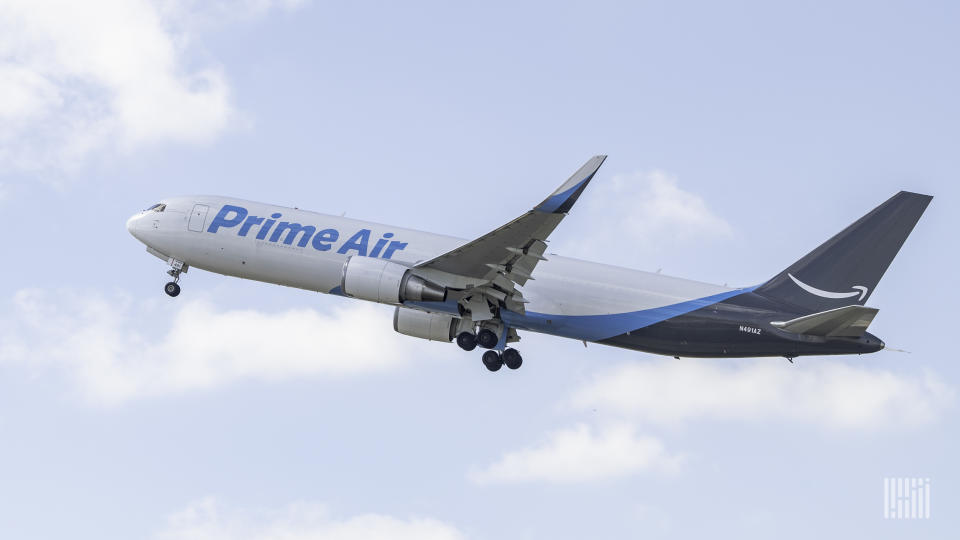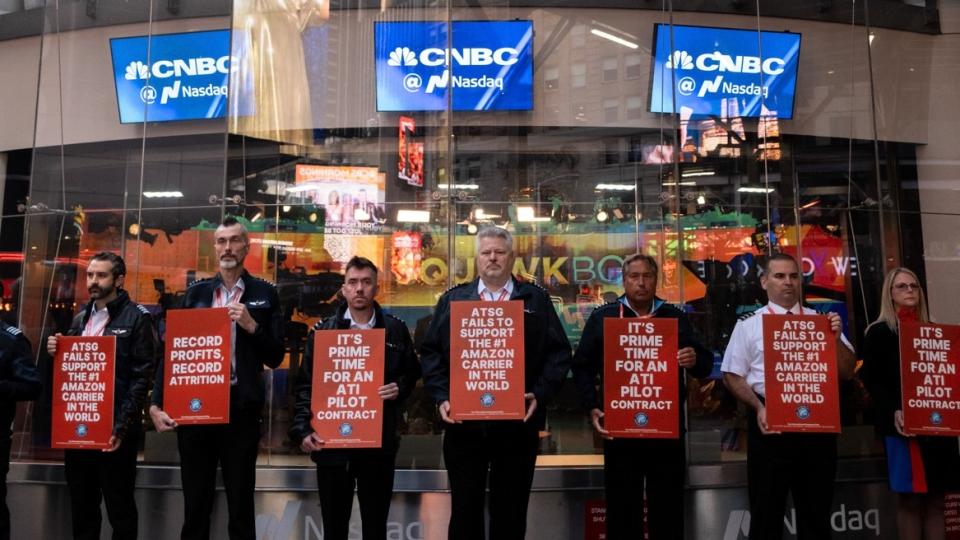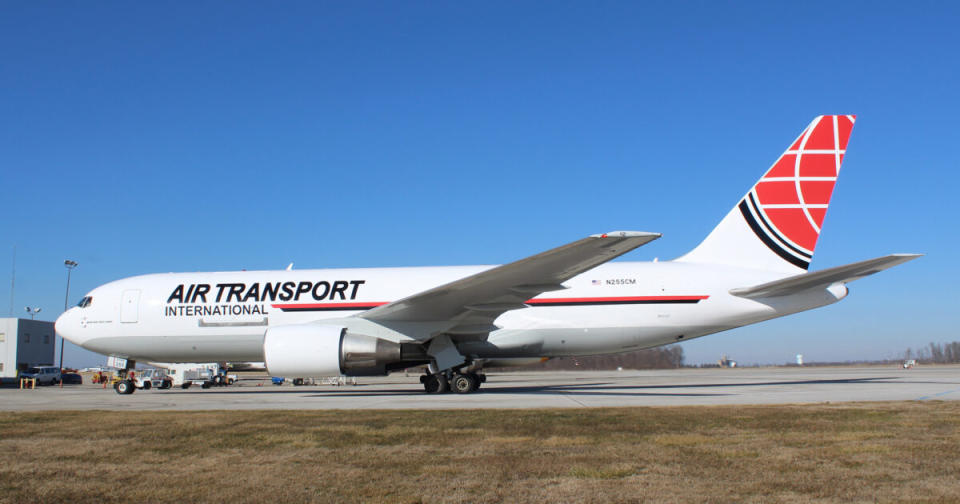Pilots flying Amazon cargo say employer stalling contract talks

MEMPHIS, Tenn. — The chair of the pilots’ union at Air Transport International, the largest air carrier in Amazon’s delivery network, accused ATI management in an interview of dragging its feet on a new contract for hundreds of pilots until the existing transportation services agreement with the mega-retailer can be renewed in two years.
Amazon’s growing e-commerce business and how pilots are compensated at other airlines that provide outsourced airlift within the retailer’s rapid fulfillment network – not the soft market for general air cargo – should be the barometer for an improved labor contract, added Mike Sterling, chair of the ATI Master Executive Council and a Boeing 767 captain, in an interview.
ATI pilots, represented by the Air Line Pilots Association (ALPA), last week asked the National Mediation Board to declare an impasse in contract negotiations and move the process to binding arbitration. The request is designed to clear the way for a potential strike against the company in a heavily regulated bargaining process. Talks, which have been underway for more than three and a half years, have broken down over pay, retirement benefits and work rules.
The subsidiary of Air Transport Services Group (NASDAQ: ATSG) operates more than 40 Boeing 767 converted freighters, according to database Planespotters.net. About 90% of the airline’s work consists of shuttling e-commerce packages to and from airports near Amazon warehouses across the nation for express delivery to customers’ doorsteps. It also flies four Boeing 757-200 combi aircraft, which can carry up to 42 people and 10 pallets of cargo, and one freighter for the U.S. Department of Defense.
“Based on our experience in negotiations, it appears that ATSG is actively delaying our agreement in an attempt to synchronize with a new air transport services agreement. We find this delay completely unacceptable as our current contract was amendable in March 2021. To impose an artificial deadline for negotiations is creating a toxic environment of pilot attrition and attraction-related problems,” Sterling told FreightWaves on Wednesday.
Management said during an earnings presentation last summer it didn’t expect to reach a labor agreement in 2023.
“In our proffer for arbitration with the National Mediation Board we emphasized executive comments made by ATSG, which clearly point to a delay posture and an impasse between the parties,” Sterling said. “Our pilots’ dedication, professionalism and commitment to deliver a fantastic product to Amazon is being eroded by the ongoing refusal by ATSG to reach an agreement.”
The interview took place here during a symposium organized by ALPA to discuss issues unique to pilots who fly freighter aircraft.
When passenger airlines face higher labor costs they can raise ticket prices and recoup the increase. ATSG lacks the same leverage with Amazon, which owns 20% of the company and has a reputation for using its market clout to get favorable pricing from suppliers.
ATSG negotiates terms of service with Amazon and determines the cost relationship with ATI, primarily hourly flight rates and aircraft lease rates. ATI rents most of its fleet from ATSG’s aircraft-leasing subsidiary and also subleases planes provided by Amazon.
“ATSG is the underlying force to reach an agreement. Pilot costs eventually are passed through in our block hour rates to our customers,” said Sterling. “ATSG has a responsibility to negotiate a market-based agreement, even though we work for ATI.”
The union branch chief dismissed suggestions that the timing for a large pay raise is bad because of the cyclical downturn in heavy airfreight, which is dominated by large business-to-business shipments, since the pandemic. Sterling said Amazon’s air network is geared toward the robust e-commerce sector and express delivery of lightweight packages to consumers, noting that Amazon posted solid results in 2023.
A strong holiday shopping season helped increase Amazon’s fourth-quarter North American retail sales by 13% year over year to $105.5 billion. The company said customers bought a record 1 billion items on its marketplace during the holiday season. Full-year sales for North America grew 13% to $353 billion. The online retailer last week said Prime deliveries in 2023 were faster than ever. More than 4 billion units were delivered by same-day or next-day service, a 65% increase from the prior year.
Sterling said ATI experienced a ramp-up in flight operations for Amazon in mid-November for the peak shipping season, as it normally does each year.
Doug Herrington, CEO of worldwide Amazon stores, in a blog post attributed Amazon’s delivery speed to the implementation of a regional rather than national fulfillment model, which shortened delivery distances, improved inventory placement and expanded the number of same-day delivery stations.
Transporting orders from in-region warehouses to local service centers minimizes the stops per package and reduces the need for air transportation. But customer deliveries over longer distances depend on Amazon Air. The online superstore has slowed the expansion of its 8-year-old air network as it matures and e-commerce demand normalizes following the COVID boom, but it has not cut flights or parked aircraft as have many all-cargo carriers, including FedEx and UPS.
According to Insider Intelligence, U.S. e-commerce sales were projected to reach $1.1 trillion in 2023, with 16.4% of all retail sales conducted online. The compound annual growth rate for retail e-commerce in the U.S. through 2027 is 11.4%, according to Statista.
“The thing that disappoints me the most is that Amazon is caught in some of the undertow of our discussions with ATSG,” Sterling said, adding that pilots delivered record reliability during the holiday shipping season and annually help generate more than $500 million in revenue for the holding company.
Closing the pay gap
In November, union members authorized leaders of the Air Line Pilots Association to call a strike over stalled labor talks once such action becomes permissible under federal law.
The union says pilots are underpaid and overworked because of unfavorable crew scheduling, which resulted in 250 pilots leaving the airline last year. ATI has about 605 pilots, but maintaining that level has come at a high cost in recruiting and training.
“We’ve lost 18 of our pilots already this month. We’ve hired 15. So we’re at net minus three” for January, Sterling said.
ATSG contends it can’t afford top-scale compensation because margins in the all-cargo sector are much less than for passenger airlines and express delivery operators. The vertically integrated aviation firm has suffered from the sharp downturn in shipping demand that gripped the freighter industry for nearly 18 months, as airline customers cut back on flight requirements and others postponed taking new aircraft leases. Pilots benefit, the company adds, by being able to reach captain level — and the higher pay rate that comes with it — much faster at Air Transport International than at a major carrier.
Through three quarters of 2023, ATSG recorded adjusted earnings before accounting measures of nearly $432 million. The full-year adjusted profit was $631 million in 2022. No date for releasing fourth-quarter results has been announced.

A Boeing 767-300 captain at ATI with 12 years of experience earns $281.87 per hour compared to $297.65 at Atlas Air, another Amazon partner. At Delta Air Lines and FedEx Express, 12-year 767 captains respectively make $349.50 and $326.51 per hour, according to ALPA data. A new labor deal last year at Amerijet, a midtier cargo airline based in Miami, significantly boosted hourly pay for pilots in the same category to $301.84.
First-year ATI pilots earn about $68,000 per year, compared to $88,000 at FedEx and $107,000 at Delta, which agreed to a new pilot contract in 2023.
Sterling said ATI pilots want a contract similar to one their counterparts at Hawaiian Airlines received last year. Hawaiian is a new entrant to the all-cargo sector after agreeing in late 2022 to operate 10 Airbus A330-330 widebody freighters for Amazon. It began operating a single cargo jet in October and Amazon is scheduled to provide eight more used aircraft this year once they have undergone a passenger-to-cargo conversion.
The four-year pilot contract at Hawaiian Airlines hikes pay nearly 33% on average, raises company retirement contributions and increases schedule flexibility, putting compensation within the ballpark of that at carriers such as FedEx, UPS and Delta.
Hawaiian likely wouldn’t have agreed to the new pay-and-benefits package if Amazon wasn’t comfortable with how that would impact the price of its service, Sterling said.
“They’re [Hawaiian executives] not going to negotiate a pilot contract that puts them substantially in the hole,” the union chief said. “The passenger operation is not in a position to subsidize cargo, so they’re looking at this as a profit center.”
Amerijet, Sterling added, also serves as a good benchmark for a contract. “Our proposals are significantly under FedEx and UPS. We just want to get halfway there.”
Management considers the union’s proposal as above the market basis.
“At the end of the day, you’ve got to have a contract that works for both sides. So if you’ve got the union side asking for FedEx or UPS wages or industry-leading, and that’s not in the cards from what we get from our customers, then that’s just not something we can agree to. So the key is finding a happy middle ground between their demands and our needs to keep things on the rails,” CEO Joe Hete said during an earnings call on Nov. 7.
Fight for vacation, less demanding schedules
One substantial sticking point involves vacation usage. Under current rules, aviators aren’t paid if approved vacation time falls on an off-duty day. Before the start of the year, pilots reserve two to four weeks of vacation, depending on seniority, which they can split in half. Pilots bid for flight hours in two-month increments. They could get a schedule that calls for working every other week, which means they will get one week of paid vacation and no money for the second week that was designated for normal rest.
“We see our pilot group lose 34% of their vacation to days off. It secures a day off, but it doesn’t come with pay as a benefit,” Sterling said.
A heavy workload is also diminishing quality of life, according to the union.
“ATI started using some more advanced crew optimization software a few years back and has packed our schedules tighter than ever. One of the reasons is that we don’t have enough pilots to have schedules that are a little bit more flexed out” while also guaranteeing minimum flight hours and complying with federal duty limitations, Sterling explained.
“You’ll continuously move yourself around the clock [with] day-night transitions. So you’re flying daytime one day and the next night you’re going out at 1 or 2 in the morning. And the next day you’re doing daytime flying again. The pilots at carriers like FedEx tend to be part of the daytime [package sortation] or part of the nighttime sort. They don’t tend to roll from one to the next.
“We have contract language that says they’ll minimize this to the extent practicable. Obviously, it’s not strong enough because they’re not minimizing it. And so, you have to start with the first part of the problem, which is staffing levels. Our staffing levels were reduced, partly for economics, to get the pilots on the property to do more than they had been previously. And then you deal with rampant attrition and a hard time attracting pilots. It kind of traps you in that loop. And it’s tough flying.”
Sterling estimated it would take a pilot cohort that was 10% larger to provide more consistent scheduling.

With such a tight labor pool, ATI is hiring inexperienced pilots who can be awarded captain slots during initial training if there is an opening and they are on the seniority list, he told FreightWaves.
“And then, the overall flight time experience has gone to absolute minimum levels. We’re seeing single-engine, fixed-gear pilots coming to work and transitioning to a 767,” Sterling said. “That’s a big leap.”
A pilot graduating from a single-engine turboprop, like a Cessna, would normally first progress to a small regional jet.
“To go from a single-engine aircraft with no gear handle to a 767 [with retractable landing gear], and the sophistication of that operation is asking a lot of that pilot,” Sterling said. “They could have never been above 10,000 feet in their career. And the speed of operations is just dramatically higher.
“Our training failure rate has risen dramatically. They either wash out or need a lot more training. And our training review boards are up 400% over the last two years.”
The committees, which are standard at every airline, meet as needed to discuss the progression of pilots who are experiencing difficulty completing training and recommend any remedial training that may be necessary.
“That means the people we’re hiring are not moving through the training pipeline like we would have seen in the past,” the pilot leader said. “At ATI, if you do two training review boards in your process, they’re probably going to discontinue your employment. Just last week, probably five pilots went out the door that didn’t complete training from being hired in the fall. So, it’s very expensive. But when you’re hiring pilots that don’t have a proven background, then that’s going to be the result.
“Aviation looks like baseball to me,” Sterling continued. “You start playing single A ball and work your way up to double A and every once in a while a guy jumps right from high school to the majors. That person is really talented. It’s the same thing in aviation. I went through the stepping stones. That’s the normal progression. And they’re just skipping all the intermediate clubs, you know, going right to the big show.”
In a statement provided to FreightWaves, ATSG said it “looks forward to ATI and its pilots’ union reaching an agreement that allows ATI to deliver service while being competitive in the market. ATI continues to attract and hire candidates that exceed the standards set forth by federal regulations. The safety and reliability of ATI has remained consistent during more than 40 years of airline operations.”
Fewer tools to pressure airlines
Getting to the point where workers can exercise their right to strike remains an uphill climb.
Collective bargaining for airlines is governed under the Railway Labor Act, which is much more restrictive than general labor law.
Under federal rules designed to prevent work interruptions in critical interstate commerce, workers are prohibited from striking and companies from locking out workers until a lengthy series of bargaining steps, including federal mediation, are completed. The federal mediator has the power to hold the parties in mediation indefinitely. ATI and the pilots’ union have been working with a mediator, who reports to the board, since late March.
Before a strike can take place, the National Mediation Board must first decide that additional mediation efforts would not be productive and offer the parties an opportunity to arbitrate the dispute before a special panel. If either side declines the arbitration, both parties enter a 30-day “cooling off” period, after which the parties can engage in self-help — a strike by the union or a lockout by management.
Arbitration in the airline industry is rare because both sides must agree to it. And, the NMB historically has been very reluctant to open the door to potential strikes, which airlines often use to their advantage in negotiations.
There is one more catch: The law allows the president to create an emergency board to investigate a labor dispute and issue a report within 30 days if the parties reject binding arbitration. That is followed by another 30-day period to consider the board’s recommendations and reach an agreement. If no agreement is reached at the end of the second cooling-off period, the parties may take action.
ATSG last week announced the retirement of ATI President James O’Grady, who led the airline subsidiary since 2016 and held a variety of roles in the corporation over a 40-year career. His replacement is Chief Operating Officer Mike Betson. Prior to joining ATI in 2021, Betson was vice president of industrial engineering for UPS.
Click here for more FreightWaves and American Shipper articles by Eric Kulisch.
RECOMMENDED READING:
Amazon’s largest cargo jet makes debut
Cargo airlines throttle back on aircraft leases, ATSG says
The post Pilots flying Amazon cargo say employer stalling contract talks appeared first on FreightWaves.
